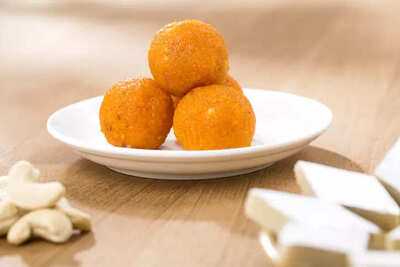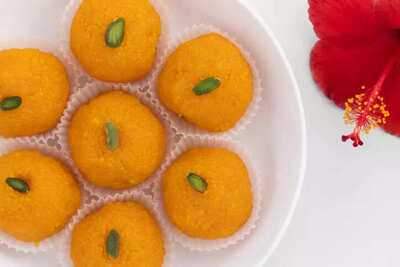It’s one of those sweets that feels timeless, golden, delicate, and glistening with ghee. Ask who invented motichoor ke laddoo, though, and you’ll find stories, not answers. Some trace it to royal kitchens, others to ancient Ayurvedic tonics once rolled for strength and healing. Over centuries, those humble balls of nourishment turned into festive jewels of sugar and saffron. Its true origin may be lost to history, but its charm never faded. Curious where it really began? Scroll down to find out.
Before Motichoor, there was Ladduka
Long before India had mithai counters lined with orange laddoos, ancient texts like the Sushruta Samhita (3rd-4th century BCE) mentioned ladduka, small round sweets used as medicine. These were made from sesame, jaggery, and nuts to boost strength and immunity. Portable and nourishing, they were part of soldiers’ rations and temple offerings.

Over the centuries, these functional “balls” became celebratory ones. Grains and pulses gave way to sugar and ghee; jaggery evolved into refined syrup. Archaeologists even found 4,000-year-old remnants of laddoo-like sweets in Rajasthan’s Harappan sites, proof that the Indian love for rolled-up sweetness goes way back.
The birth of crushed pearls
The word motichoor means “crushed pearls,” and that’s exactly what it looks like - hundreds of tiny golden boondis bound by syrup into one soft, melt-in-the-mouth sphere. Most historians agree that motichoor ke laddoo evolved from the older boondi laddoo . The difference lies in the scale of the droplets: motichoor uses much finer boondi, giving it a smoother texture and richer taste.
The innovation likely came from halwais (traditional sweet-makers) experimenting with batter consistency and perforated ladles. Somewhere between the frying pans of Rajasthan and Uttar Pradesh , a halwai decided to make the boondis smaller, creating a laddoo so luxurious it looked like a string of pearls compacted into one orb.
Royal kitchens and local legends

One story places Motichoor’s birth in Rajasthan’s royal kitchens, where sweets were not just desserts but status symbols. Cooked in pure desi ghee, tinted saffron-yellow, and perfumed with cardamom, motichoor laddoos became royal indulgence, served in silver trays and offered during temple rituals.
Another theory ties it to Uttar Pradesh and Bihar, regions with deep laddoo traditions and temple-based sweet making. Some even whisper about a halwai from Bhopal named Motichoor who “invented” the sweet, though no evidence exists beyond local lore. Like most Indian food legends, the tale is charming, unverifiable, and probably part of its appeal.
The laddoo that travelled
What began in the heartlands of North India soon travelled everywhere. From temple prasad in Varanasi to wedding trays in Delhi, from Diwali boxes to office celebrations, motichoor laddoo became the symbol of festivity itself. Even Bollywood joined - in those feel-good moments on screen where someone always shows up with a box of laddoos to celebrate life’s little victories.

Part of its charm lies in its contradictions: simple ingredients, gram flour , ghee, sugar, transformed into something regal. Every bite carries crunch, softness, and syrup in perfect rhythm, reminding you that good sweets don’t just taste sweet, they feel celebratory.
So, who really invented it?
If you’re looking for a single name, you won’t find one. Motichoor ke laddoo wasn’t invented by one genius but by generations of halwais refining, experimenting, and perfecting. It’s a collective creation - a result of India’s long love affair with sweet-making, innovation born of devotion and everyday craftsmanship.
What we can say for sure is this: by the time motichoor arrived, the idea of the laddoo was already ancient. All it took was a creative mind, a finer sieve, and a little royal ambition to turn humble boondi into crushed pearls.
So maybe that’s the real inventor - not a person, but an instinct. The Indian instinct to take something ordinary and make it shine.
Before Motichoor, there was Ladduka
Long before India had mithai counters lined with orange laddoos, ancient texts like the Sushruta Samhita (3rd-4th century BCE) mentioned ladduka, small round sweets used as medicine. These were made from sesame, jaggery, and nuts to boost strength and immunity. Portable and nourishing, they were part of soldiers’ rations and temple offerings.

Over the centuries, these functional “balls” became celebratory ones. Grains and pulses gave way to sugar and ghee; jaggery evolved into refined syrup. Archaeologists even found 4,000-year-old remnants of laddoo-like sweets in Rajasthan’s Harappan sites, proof that the Indian love for rolled-up sweetness goes way back.
The birth of crushed pearls
The word motichoor means “crushed pearls,” and that’s exactly what it looks like - hundreds of tiny golden boondis bound by syrup into one soft, melt-in-the-mouth sphere. Most historians agree that motichoor ke laddoo evolved from the older boondi laddoo . The difference lies in the scale of the droplets: motichoor uses much finer boondi, giving it a smoother texture and richer taste.
The innovation likely came from halwais (traditional sweet-makers) experimenting with batter consistency and perforated ladles. Somewhere between the frying pans of Rajasthan and Uttar Pradesh , a halwai decided to make the boondis smaller, creating a laddoo so luxurious it looked like a string of pearls compacted into one orb.
Royal kitchens and local legends
One story places Motichoor’s birth in Rajasthan’s royal kitchens, where sweets were not just desserts but status symbols. Cooked in pure desi ghee, tinted saffron-yellow, and perfumed with cardamom, motichoor laddoos became royal indulgence, served in silver trays and offered during temple rituals.
Another theory ties it to Uttar Pradesh and Bihar, regions with deep laddoo traditions and temple-based sweet making. Some even whisper about a halwai from Bhopal named Motichoor who “invented” the sweet, though no evidence exists beyond local lore. Like most Indian food legends, the tale is charming, unverifiable, and probably part of its appeal.
The laddoo that travelled
What began in the heartlands of North India soon travelled everywhere. From temple prasad in Varanasi to wedding trays in Delhi, from Diwali boxes to office celebrations, motichoor laddoo became the symbol of festivity itself. Even Bollywood joined - in those feel-good moments on screen where someone always shows up with a box of laddoos to celebrate life’s little victories.
Part of its charm lies in its contradictions: simple ingredients, gram flour , ghee, sugar, transformed into something regal. Every bite carries crunch, softness, and syrup in perfect rhythm, reminding you that good sweets don’t just taste sweet, they feel celebratory.
So, who really invented it?
If you’re looking for a single name, you won’t find one. Motichoor ke laddoo wasn’t invented by one genius but by generations of halwais refining, experimenting, and perfecting. It’s a collective creation - a result of India’s long love affair with sweet-making, innovation born of devotion and everyday craftsmanship.
What we can say for sure is this: by the time motichoor arrived, the idea of the laddoo was already ancient. All it took was a creative mind, a finer sieve, and a little royal ambition to turn humble boondi into crushed pearls.
So maybe that’s the real inventor - not a person, but an instinct. The Indian instinct to take something ordinary and make it shine.
You may also like

Former tennis world No. 1 who announced retirement aged 23 shares concerning health update

Steven Gerrard makes shock Rangers call as Russell Martin replacement decision made

Followed 'dharma yuddh' in Operation Sindoor, says General Dwivedi

'Free and open Indo-Pacific': US ambassador-designate Sergio Gor meets NSA Doval; discusses defence, trade and technology

Diane Keaton dead: Godfather and First Wives Club actress dies at the age of 79





